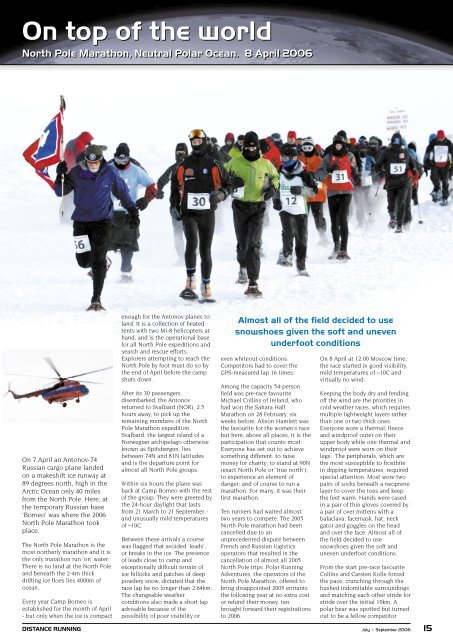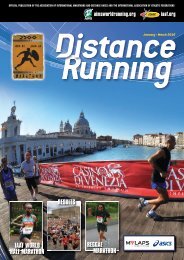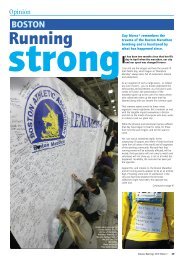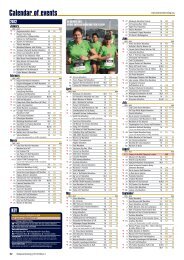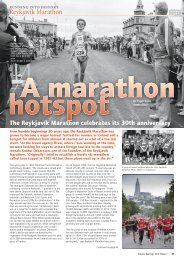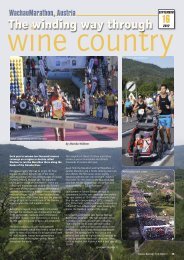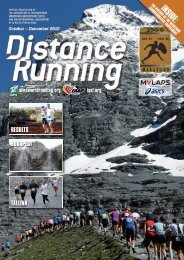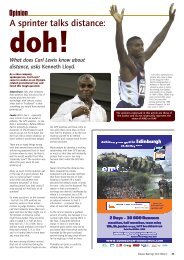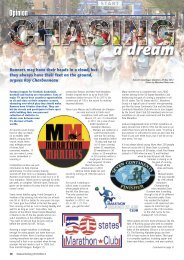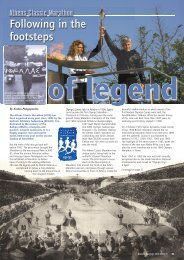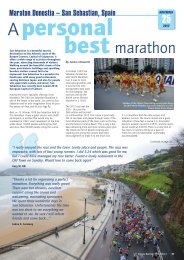Download pdf - Distance Running magazine
Download pdf - Distance Running magazine
Download pdf - Distance Running magazine
Create successful ePaper yourself
Turn your PDF publications into a flip-book with our unique Google optimized e-Paper software.
On top of the world<br />
North Pole Marathon, Neutral Polar Ocean. 8 April 2006<br />
On 7 April an Antonov-74<br />
Russian cargo plane landed<br />
on a makeshift ice runway at<br />
89 degrees north, high in the<br />
Arctic Ocean only 40 miles<br />
from the North Pole. Here, at<br />
the temporary Russian base<br />
‘Borneo’ was where the 2006<br />
North Pole Marathon took<br />
place.<br />
The North Pole Marathon is the<br />
most northerly marathon and it is<br />
the only marathon run ‘on’ water.<br />
There is no land at the North Pole<br />
and beneath the 2-4m thick<br />
drifting ice floes lies 4000m of<br />
ocean.<br />
Every year Camp Borneo is<br />
established for the month of April<br />
- but only when the ice is compact<br />
enough for the Antonov planes to<br />
land. It is a collection of heated<br />
tents with two Mi-8 helicopters at<br />
hand, and is the operational base<br />
for all North Pole expeditions and<br />
search and rescue efforts.<br />
Explorers attempting to reach the<br />
North Pole by foot must do so by<br />
the end of April before the camp<br />
shuts down.<br />
After its 30 passengers<br />
disembarked, the Antonov<br />
returned to Svalbard (NOR), 2.5<br />
hours away, to pick up the<br />
remaining members of the North<br />
Pole Marathon expedition.<br />
Svalbard, the largest island of a<br />
Norwegian archipelago otherwise<br />
known as Spitsbergen, lies<br />
between 74N and 81N latitudes<br />
and is the departure point for<br />
almost all North Pole groups.<br />
Within six hours the plane was<br />
back at Camp Borneo with the rest<br />
of the group. They were greeted by<br />
the 24-hour daylight that lasts<br />
from 21 March to 21 September -<br />
and unusually mild temperatures<br />
of –10C.<br />
Between these arrivals a course<br />
was flagged that avoided ‘leads’,<br />
or breaks in the ice. The presence<br />
of leads close to camp and<br />
exceptionally difficult terrain of<br />
ice hillocks and patches of deep<br />
powdery snow, dictated that the<br />
race lap be no longer than 2.64km.<br />
The changeable weather<br />
conditions also made a short lap<br />
advisable because of the<br />
possibility of poor visibility or<br />
Almost all of the field decided to use<br />
snowshoes given the soft and uneven<br />
underfoot conditions<br />
even whiteout conditions.<br />
Competitors had to cover the<br />
GPS-measured lap 16 times.<br />
Among the capacity 54-person<br />
field was pre-race favourite<br />
Michael Collins of Ireland, who<br />
had won the Sahara Half<br />
Marathon on 28 February, six<br />
weeks before. Alison Hamlett was<br />
the favourite for the women’s race<br />
but here, above all places, it is the<br />
participation that counts most.<br />
Everyone has set out to achieve<br />
something different: to raise<br />
money for charity; to stand at 90N<br />
(exact North Pole or ‘true north’);<br />
to experience an element of<br />
danger; and of course to run a<br />
marathon. For many, it was their<br />
first marathon.<br />
Ten runners had waited almost<br />
two years to compete. The 2005<br />
North Pole marathon had been<br />
cancelled due to an<br />
unprecedented dispute between<br />
French and Russian logistics<br />
operators that resulted in the<br />
cancellation of almost all 2005<br />
North Pole trips. Polar <strong>Running</strong><br />
Adventures, the operators of the<br />
North Pole Marathon, offered to<br />
bring disappointed 2005 entrants<br />
the following year at no extra cost<br />
or refund their money: ten<br />
brought forward their registrations<br />
to 2006.<br />
On 8 April at 12.00 Moscow time,<br />
the race started in good visibility,<br />
mild temperatures of –10C and<br />
virtually no wind.<br />
Keeping the body dry and fending<br />
off the wind are the priorities in<br />
cold weather races, which requires<br />
multiple lightweight layers rather<br />
than one or two thick ones.<br />
Everyone wore a thermal, fleece<br />
and windproof outer on their<br />
upper body while one thermal and<br />
windproof were worn on their<br />
legs. The peripherals, which are<br />
the most susceptible to frostbite<br />
in dipping temperatures, required<br />
special attention. Most wore two<br />
pairs of socks beneath a neoprene<br />
layer to cover the toes and keep<br />
the feet warm. Hands were cased<br />
in a pair of thin gloves covered by<br />
a pair of over mittens with a<br />
balaclava, facemask, hat, neck<br />
gator and goggles on the head<br />
and over the face. Almost all of<br />
the field decided to use<br />
snowshoes given the soft and<br />
uneven underfoot conditions.<br />
From the start pre-race favourite<br />
Collins and Carsten Kolle forced<br />
the pace, crunching through the<br />
hushed indomitable surroundings<br />
and matching each other stride for<br />
stride over the initial 10km. A<br />
polar bear was spotted but turned<br />
out to be a fellow competitor<br />
DISTANCE RUNNING July – September 2006<br />
15


